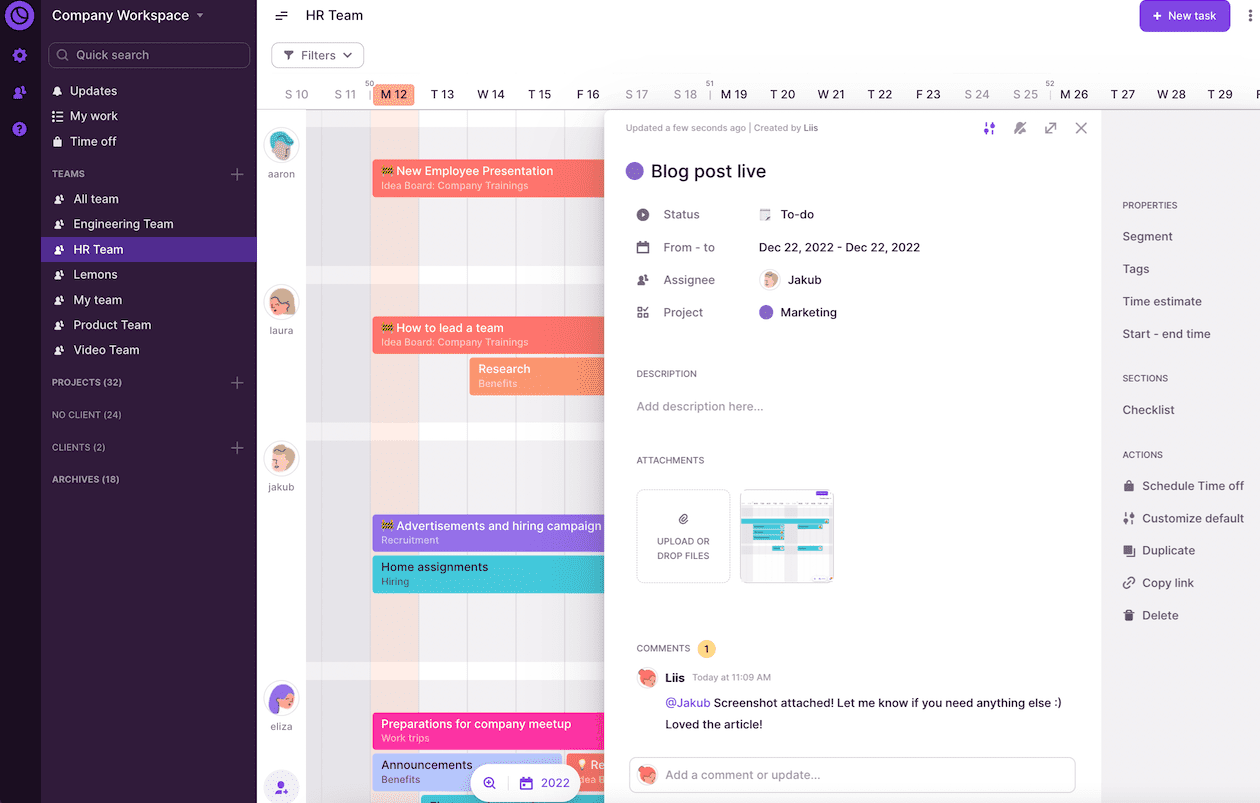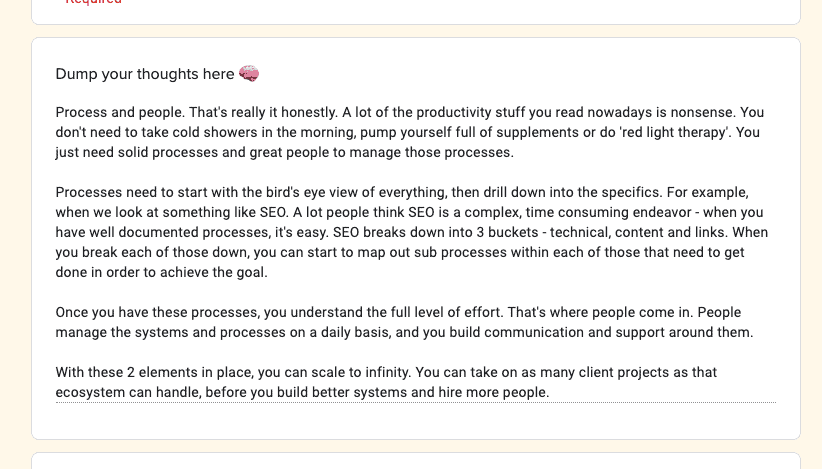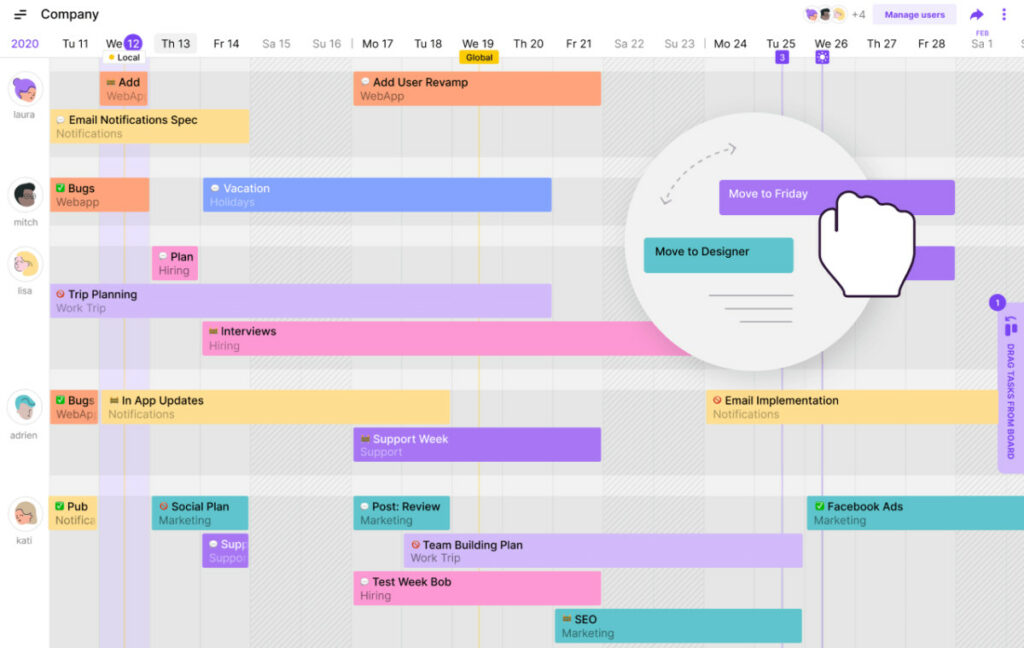Client projects can be a nightmare. You start so well, only to be stressed out, overworked, and scrambling to keep the project afloat.
“Scope creep has entered the chat.” 💀
Scope creep is the silent killer for a lot of projects. But you can keep it at bay and even prevent it from happening.
In this guide, you’ll learn about the causes of scope creep, its consequences, and strategies to fight against it. 💪
What is project scope?
Project scope refers to a project’s specific goals, deliverables, tasks, and boundaries.
Defining a project’s scope helps you establish the boundaries of the work required to complete the project successfully.
What is scope creep in project management?
Scope creep in project management is when a project’s scope keeps expanding without proper control, leading to delays, higher costs, and potential quality issues.
Causes of scope creep with examples
Scope creep occurs for many reasons. So let’s run through the most common causes.
1. Unclear scope
An unclear scope is exactly what you think it is. A scope that has unclear goals, deliverables, tasks, and boundaries.
Don’t be vague about the project’s scope—if you do, you’ll end up on the scope creep wheel of doom.
Example
A web development agency goes ahead with a project with a loosely defined goal like “create a modern website.” The project team goes back and forth with the client on features and design, causing the project timeline to be constantly pushed back.
What can you do about it?
Get to the root of a problem.
Why does a client want a “modern website”—what’s the purpose?
The 5 Whys technique can help you out here.
Here’s what the 5 Whys might look like during a project requirements gathering meeting for a “modern” website.
Client: “We want a new modern website.”
You: “Why do you need a new website?”
Client: “The old one doesn’t work for us anymore.”
You: “Why does the old website not work?”
Client: “Our business has changed.”
You: “Why has your business changed?”
Client: “We’re handling more customers than we used to.”
You: “Why does the old website not support more customers?”
Client: “The old website lacks features for online transactions, so our staff has to do everything manually.”
This approach will help you reach an identifiable problem, translating to a clear project requirement.
The problem is that your client won’t always express the root of the problem while talking. Often, the problem is so ingrained and obvious that they forget to say it out loud. 🤷
Getting to the root cause of why the client wants to spend money on a project will help you to define and document the project scope and deliverables—helping you to avoid scope creep.
Create a Work Breakdown Structure to help you better define the project scope and deliverables.
2. Poorly defined project requirements
Poorly defined project requirements are where you find yourself in a situation where your team hasn’t a clue what they’re doing because the project goals, objectives, tasks, and deliverables are unclear.
Example
A branding agency is hired to create a new visual identity for a client. But doesn’t work with the client to understand their brand values, target market, or design preferences, leading to multiple iterations and an expanded scope as the project evolves.
What can you do about it?
Invest time in thorough project planning and create a foolproof requirements-gathering process for all projects.
Gathering project requirements will help you to:
- Understand the scope of work
- Identify and assess all project risks
- Accurately estimate the cost of the project
- Create a project timeline the client is happy with
- Effectively allocate and manage project resources
- Not obliterate the project budget on irrelevant “requirements.”
To stay organized as you grow and juggle projects, you need to build a process that collects, translates, and shares requirements from the client to the team so that you can get it right time after time.
3. Poorly defined project deliverables
Not clearly stating what is and isn’t within a project’s scope leaves room for disagreements and different expectations.
Being clear upfront is always better.
Assuming you’re on the same page and leaving the details in the air opens the backdoor to scope creep.
Awkward meeting incoming!
Example
A graphic design agency is hired to create a new logo for a client, but the agency and client don’t specify the required formats, color variations, or additional branding elements, leading to ambiguity and potential scope changes.
What can you do about it?
Start by gathering all project requirements and defining the project phases and deliverables.
Once you’ve done this, create an air-tight statement of work that lists what is and isn’t included within the project’s scope.
“But do I really need a statement of work?”

🚨📱🚨
It’s your client calling.
They thought copywriting was already included in the package and were not happy to get charged extra.
Do you really need a statement of work?
Short answer? Yes.
Please create one. It’ll save you a world of pain later.
The purpose of an SOW is not to catch a client off guard but to establish a clear understanding of the exact work being done, the methods, the timeline, and the associated costs.
4. Unrealistic deadlines or budget constraints
Tight deadlines or budgets wreak havoc on the scope of a project.
I know from experience that agencies can get into the habit of accepting projects with crazy deadlines and peanut-sized budgets because “we need more revenue.”
But accepting whatever work you can get your hands on, without properly scoping the project out and assessing its profitability, is a guaranteed way of de-railing all other projects.
You skim over project planning, create a super vague scope of work, and promise the world to get the project and money in the door.
Which more often than not leads to:
- A chaotic project
- A deadline that can’t be met
- A budget that is blown into smithereens
- A client that never wants to work with you again
- A stressed team that can’t handle their workload
Example
An agency agrees to develop a series of promotional videos for a client within a tight budget. As the project progresses, the client requests additional edits and features, which the agency accommodates without adjusting the budget, reducing project profitability, and negatively affecting other projects.
What can you do about it?
If the client doesn’t budge on their deadline and budget for the project, you can:
- Say no to the work
- Only complete a percentage of the work
But always remember to try to:
- Set realistic deadlines and budgets
- Communicate limitations to the client
- Regularly review progress and adjust as needed
5. Not involving key stakeholders
Failing to include key stakeholders during the planning process is another easy way to let scope creep take control.
Example
An advertising agency fails to consult the client’s sales and product team before creating a campaign. Upon review, the campaign aligns differently from the product launch and sales strategy, requiring revisions and causing scope creep.
What can you do about it?
The best way to avoid this from happening is to:
- Identify key project stakeholders
- Get them involved in the project kick-off meeting
- Collect their input, ideas, and expectations for the project
- Set agreed-upon project goals, deliverables, and expectations
6. Poor communication
A lack of consistent communication between you and your clients throughout a project’s lifecycle can lead to misunderstandings, misaligned expectations, and scope creep.
Example
An advertising agency is working on a new campaign for a client, but due to poor communication, the creative team is unaware of the client’s updated branding guidelines. As a result, they develop ads that do not align with the new brand identity, leading to scope changes and additional work.
What can you do about it?
Maintain open, transparent, and regular communication among team members and your client.
Refrain from assuming you know what the client is thinking. Think about creating a project communication plan to manage client expectations better, manage scheduling risks, and deliver successful projects on time.
You can use a tool like Toggl Plan when managing projects. Features such as comments and the ability to share project timelines can ensure everybody is on the same page.

Depending on the project’s complexity, you may also consider having regular project status report meetings to mitigate scope creep.
They are perfect for:
- Information sharing
- Facilitating feedback
- Maintaining accountability
- Identifying risks and issues
Check out our ‘How to Write a Project Status Report‘ to learn more.
7. Clients changing expectations
The expectations of deliverables may change in complex projects involving multiple stakeholders.
Expectations may change due to conditions out of your control, such as market conditions, competitive pressures, or internal organizational priorities.
Example
A marketing agency is working on a rebranding project for a client. But after a competitor’s rebrand gains significant attention, the client requests a more aggressive brand positioning and a different visual identity to stand out in the market.
What can you do about it?
You can’t plan and predict everything when working with clients.
But your best options here are to:
- Establish clear objectives from the outset
- Involve the client in regular reviews and updates
- Implement a change control process to manage any scope adjustments
8. Additional client requests
Clients love asking for work outside of scope.
Of course, you want to say yes to more work. But your “yes” should not be unconditional.
Communicating your terms upfront helps remove additional project requests from your list of cluster headache triggers.
Example
An agency is developing a mobile app for a client with agreed scope. The client introduces new ideas and requests additional features and design changes beyond the scope.
What can you do about it?
Clients are happy to throw extra requests into the ring—fully expecting no additional charge.
Scope creep with scope creep sprinkles on top.
Here’s what you can do in this scenario:
- Create a detailed project scope
- Get the client to sign off on a statement of work
- Set up a communication plan and regularly meet with the client
- Implement a change control process for assessing, approving, and managing requested changes
- Monitor project progress to keep track of the project’s progress and ensure alignment with the agreed-upon scope
9. Lack of change control process
When the scenario of a client requesting work out of scope inevitably happens, a lack of a change control process will be the project’s death.
A change control process is simply an approach to managing and documenting additional work requests from the client that fall outside the project scope.
Example
A web development agency works on a website redesign without a change control process. The client requests additional features and design tweaks, which the team implements without evaluation. This leads to scope creep, delays, and cost overruns.
What can you do about it?
If you aren’t charging for the “little extras,” you’ll risk scope creep sucking the project budget dry.
Here are three ways to best handle additional requests as part of your change control process:
| Understand the intent behind the request | Understanding why the client is asking for additional work is essential. You may realize there is a more straightforward solution you can add without additional costs to the client. |
| Accept the additional request and charge accordingly | You can accept the request and inform the client that additional resources are needed. |
| Let it slide. At no extra cost | Acknowledge that the request is outside of the original scope. But as it’s easy, let it slide and dress it up as a “favor”. Let them know that any more significant requests will have to be charged. |
It’s healthy to set boundaries with clients, charge for little extras, or acknowledge the request and let them know it will cost extra. Communicate with them, and both parties will be better for it.
10. No risk management plan
We often plan a project with this overly optimistic mindset. Never considering the myriad of project risks out there.
Before you know it, you’re mid-project and starting to feel the heat.

Most projects “fail” for one reason or another, and not properly assessing project risks is one of them.
A project risk assessment and management plan helps to identify, assess, and address potential risks impacting a project’s scope, timeline, resources, or quality.
Example
An advertising agency manages a client’s social media advertising campaign. Without a risk management plan, they fail to anticipate changes in the social media platform’s advertising policies, leading to a sudden need for revised ad creatives and targeting strategies, causing scope creep.
What can you do about it?
Assess all project risks and create a risk management plan to combat them. Doing so will enhance project success and reduce the likelihood of scope creep, delays, and cost overruns.
11. Inexperienced project team
Team members lacking experience may not plan the project effectively, resulting in unrealistic expectations, unclear requirements, or incorrect resource allocation, which can lead to scope changes during the project.
Example
A marketing agency with an inexperienced project team is hired for a complex ad campaign. The team underestimates the resources needed and fails to anticipate potential issues, leading to scope creep, budget overruns, and missed deadlines.
What can you do about it?
Hiring the right people is probably the biggest challenge for many agencies.
You’re gonna hire and fire a lot of people.
But what type of people do you need for client work?
Chris from The Futur goes through two different types of people to hire in the video below:
- Processes people: people who can follow processes and playbooks to a tee, but panic when a scenario occurs where a process doesn’t exist.
- Non-processes people: people who can think outside the box when there isn’t a process. They understand the problem, assess it, and make decisions to solve them.
You’ll want a mixture of both for your project teams.
Processes people are the type of people you want working on the project and following your frameworks and processes.
Non-processes people are the ones you need to manage the entire project.
How do you document your processes? By creating Standard Operating Procedures (SOPs).
An SOP is a set of step-by-step instructions that outline how to perform a specific task or activity consistently and efficiently.
Ask any successful business owner what helped them to scale, and they’ll mention processes/SOPs.
We used a survey to ask several agency owners how they simultaneously kept on top of multiple client projects.
One answer that kept popping up?
Processes — aka SOPs.
Check out this answer from self-proclaimed “process nerd” Ryan Stewart…

Processes helped Ryan’s digital agency, Webris, generate millions of dollars for his clients.
By providing clear, step-by-step instructions for performing project tasks, SOPs can help to:
- Increase the quality of output and efficiency of your existing team.
- Help new employees get up to speed on how you deliver client projects.
12. Lack of project management tools
54% of project managers don’t have real-time access to key performance indicators (KPIs).
So how can they even monitor project performance or plan accurately?
They can’t.
Without the right tools, you’ll constantly be asking yourself:
- What resources do I have available for projects?
- How profitable is this project?
- Can we take on more work?
Example
A small software development team is working on a new application without using any project management tools. As a result, scope creep sets in as they struggle to track tasks, deadlines, and progress, leading to miscommunications and missed milestones.
What can you do about it?
- Invest in project management software
- Train team members on how to use each one
Note: Spreadsheets are not proper project management tools. 😎
You can use a tool like Toggl Plan to visually plan your team’s projects, track progress, and manage resources with drag-and-drop timelines.

And use Toggl Track to track project costs, such as:
- Labor costs
- Contractor costs
- Project budget and profitability

How to prevent scope creep—your mini plan of action
You will have noticed that many of the tips we shared above fall into the realm of effective project planning.
So let’s put them all together and create your scope creep prevention plan.
| Step | Description |
|---|---|
| Define the scope | Gather all project requirements and define the scope, including the objectives, goals, and deliverables. Put it all together in a statement of work. |
| Make a plan with clear timelines and processes | Develop a step-by-step plan, set a project timeline, assign teams, and create processes for any task performed frequently. Use project management tools to help with organization. |
| Maintain clear communication | Regularly communicate with the client and your team using tools project management tools. Have regular check-ins and updates with your team and client to ensure everyone is on the same page. |
| Track and monitor everything | Use project management tools to monitor and track project progress. Track all project data, including time spent on tasks and employee working hours. |
How to manage scope creep mid-project
Projects never go to plan. Scope creep will inevitably happen.
So what do you do when it does come your way mid-project?
Here’s our recommended plan of action:
- Recognize the signs: Identify instances where the project’s scope has expanded beyond the initial plan or when new tasks, goals, or requirements are being added.
- Assess the impact: Evaluate the impact of scope changes on the project’s timeline, budget, resources, and overall objectives.
- Revisit project goals: Review the original project goals and objectives to ensure the proposed changes align with them.
- Communicate with stakeholders: Discuss the scope changes with stakeholders, clients, and team members, and explain the potential consequences (deadlines pushed back or budget increase required).
- Implement a change control process: Establish a formal process to evaluate, approve, and document any changes to the project scope. Make sure to involve all relevant stakeholders in this process.
- Prioritize changes: Determine which changes are essential for project success and which can be deferred or eliminated. Focus on high-priority changes that align with the project goals.
- Revise the project plan: Update the timeline and budget to accommodate the approved changes. Communicate these updates to all stakeholders and team members.
- Monitor and control: Regularly review the project’s progress and scope to ensure that any additional changes are managed through the change control process.
- Learn and adapt: Use the experience of managing scope creep mid-project to improve your planning and management processes for future projects.
No more creeping your scope
Avoiding scope creep in project management can seem impossible, but it’s not a pipe dream.
Sure, sometimes you’ll still get demanding clients or change requests.
But by defining and communicating your capacity upfront in terms of boundaries, service costs, timelines, and extras, you’ll be equipped to handle this much better in the future.
You might even profit from it!
Sean is a Content Marketer at Toggl. He's been involved in SEO and Content Marketing since 2017. Before working for Toggl, Sean ran SEO at a digital marketing agency—so he's all too familiar with time tracking and project management.









![What is Project Resource Management? [Comprehensive Guide]](images/project-resource-management-112x67.jpg)


![10 Best Capacity Planning Software & Tools [2024]](images/capacity-planning-tools-675x404.jpg)
![Parametric Estimating in Project Management [Definitive Guide]](images/parametric-estimating-677x404.jpg)
